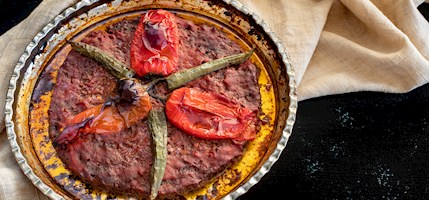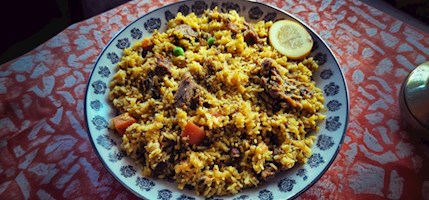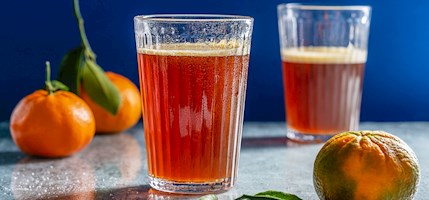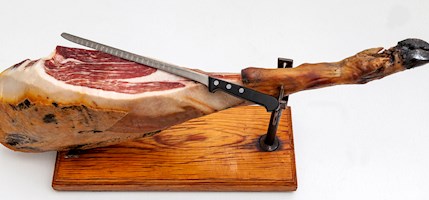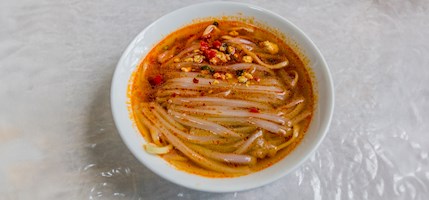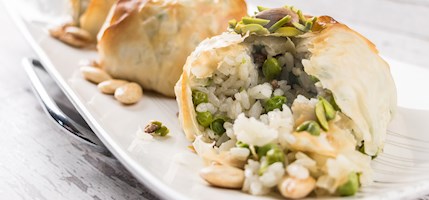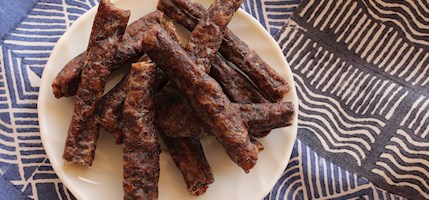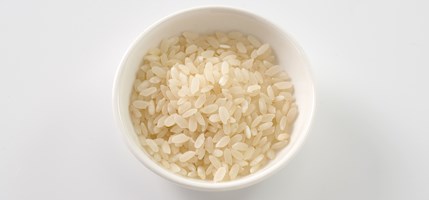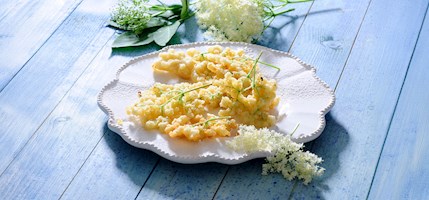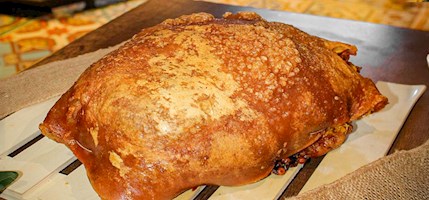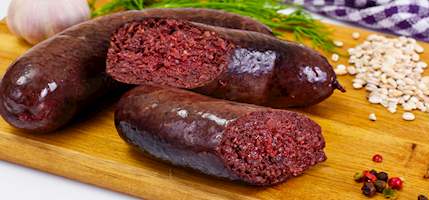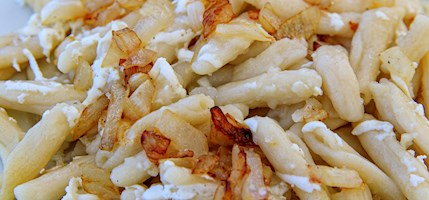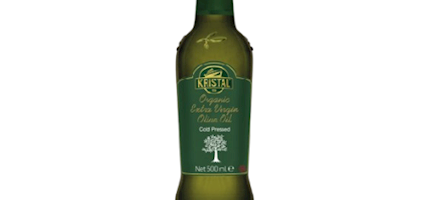Kilis tava
Kilis Tava is a minced meat dish baked in a tray, originating from the city of Kilis in southeastern Turkey near the Syrian border. It is prepared using finely ground lamb or a combination of lamb and beef, mixed with chopped vegetables, garlic, onions, parsley, and regional spices. The seasoned mixture is spread evenly over a shallow metal tray, often topped with sliced peppers, tomatoes, or potatoes, and baked in a wood-fired or household oven until well-cooked and lightly browned. Kilis tava is not only a household dish but also part of the shared food culture in Kilis, where local butchers frequently prepare the raw mixture by request. Customers bring their meat, have it ground and mixed with seasonings, then take the assembled tray to a bakery for cooking. This cooperative method of preparation highlights a practical and social aspect of the local food economy. The finished dish is typically served hot, cut into slices, accompanied by flatbread, fresh herbs, and light salads or yogurt-based sides. Its taste is rich but balanced, relying on the natural flavors of the meat and vegetables rather than heavy sauces or marinades. Kilis tava is often compared to similar dishes from nearby cities, such as tepsi kebabı in Hatay, but it maintains its own identity through specific seasoning choices and preparation customs that have remained consistent over time.
Leberknödel
Leberknödel is a type of liver dumpling originating from southern Germany and Austria, especially associated with the regions of Bavaria, Swabia, and parts of Austria such as Salzburg and Upper Austria. The dish consists of finely ground liver, commonly from beef or pork (sometimes even veal), combined with stale bread rolls soaked in milk, eggs, onions, fresh herbs, and spices to create a dense, flavorful mixture that can be shaped into large, round dumplings. The liver is typically minced or passed through a grinder until smooth, then carefully mixed with the other ingredients to form a cohesive mass. Once shaped, Leberknödel are gently simmered in salted water or clear broth until firm and cooked through. These dumplings are commonly served in two main ways. They can be presented in a clear beef broth as a soup, known as Leberknödelsuppe, where the dumpling absorbs some of the broth’s flavor while adding richness to the liquid. Alternatively, they are served as a more substantial main dish accompanied by sauerkraut and boiled or mashed potatoes. The flavor is distinctly savory and robust, reflecting the use of liver and the aromatic additions of marjoram, parsley, and occasionally nutmeg or pepper. Preparation requires attention to achieve the correct texture, which should be tender but not falling apart when cooked. Leberknödel has a long history as a practical and nourishing food in rural and urban settings, where no part of the animal was wasted and organ meats were valued for their nutritional content. Today, it appears in both everyday cooking and regional restaurant menus, especially in southern Germany and Austria, where it remains an example of regional comfort food made with simple, accessible ingredients. The dumplings are typically prepared fresh, although they can also be made in advance and reheated in broth.
Empanada de carne
Empanada de carne is a meat-filled pie that's especially popular in regions like Galicia, Andalusia, and Castile and León. It typically features a savory filling of ground or shredded beef (sometimes pork), cooked with onions, garlic, peppers, tomato, and a blend of paprika or other spices, all encased in a golden pastry crust. It can be made with different types of dough—most commonly yeasted dough, but also shortcrust or puff pastry, depending on the regional or household tradition. It's baked as a large rectangular or round pie and then sliced into squares, or it can be baked or fried as individual hand pies. This hearty pie is commonly served warm or at room temperature, making it perfect for family meals, picnics, festivals, or as a tapa in Spanish bars. Some variations also include ingredients like hard-boiled eggs, raisins, or olives, reflecting a sweet-and-savory contrast found in many Mediterranean meat dishes.
Fisksoppa
Fisksoppa is a rich and flavorful fish soup that hails from the coastal regions of Sweden, where fishing has long played a vital role in local food culture. The emergence of fisksoppa can be linked to the abundance of fish in the Baltic Sea and surrounding waters, along with the need for a warming, satisfying dish that utilizes locally available ingredients. Over generations, the recipe has been refined to include a variety of fish such as cod, salmon, or perch, combined with root vegetables like carrots, potatoes, and leeks. Cream and sometimes white wine are added to enrich the broth, providing a silky texture that enhances the delicate taste of the fish. Preparation begins with gently simmering a broth made from fish bones or stock, which imparts depth to the soup. Chunks of fresh fish and vegetables are added and cooked until tender but still firm. The final stage involves stirring in cream and fresh herbs, typically dill or parsley, to complete the dish. This careful layering ensures that the flavors remain distinct yet balanced, allowing each ingredient to contribute to the overall complexity. Fisksoppa is commonly served hot, often accompanied by crusty bread or crisp flatbread to soak up the flavorful broth. It is enjoyed throughout Sweden, particularly in coastal towns and during colder months when its warmth and heartiness are most appreciated.
Double India Pale Ale
Double India Pale Ale, often abbreviated as Double IPA or Imperial IPA, is a style of beer that originated in the United States as an intensified variation of the classic India Pale Ale. Known for its bold hop character and higher alcohol content, Double IPA emerged from the American craft brewing movement in the late 20th century, which sought to push the boundaries of flavor and strength beyond traditional British IPA offerings. This beer style is characterized by a significantly increased use of hops during brewing, resulting in a pronounced bitterness balanced by substantial malt backbone and a rich, often complex aroma and taste profile. The development of Double IPA is linked to the experimentation and innovation within the craft beer scene, particularly in the Pacific Northwest, where breweries began increasing hop quantities to appeal to enthusiasts seeking more intense flavors. This style quickly gained popularity due to its assertive bitterness, citrusy and piney hop aromas, and robust malt presence that provides balance and drinkability despite the elevated alcohol levels, which commonly range from 7.5% to over 10% ABV. The history of Double IPA reflects a broader trend in craft brewing toward bold, distinctive beers that challenge conventional norms. Preparation of Double IPA involves a careful balance of malt and hops, often utilizing multiple hop additions throughout the brewing process to layer bitterness, flavor, and aroma. Brewers select hop varieties that contribute citrus, floral, pine, resinous, or tropical fruit notes, with the malt bill designed to support these intense hop characteristics without overpowering them. The fermentation process employs yeast strains that enhance hop expression and maintain clarity and freshness. Serving Double IPA typically involves pouring it into tulip or pint glasses, which help concentrate the beer's complex aromas and showcase its often deep golden to amber hues. The beer is best served slightly chilled to allow the full spectrum of flavors to emerge. Double IPA is enjoyed globally among craft beer drinkers, often featured in taprooms, beer festivals, and specialty bars that celebrate hop-forward styles. Its bold profile pairs well with a variety of foods, from spicy dishes and grilled meats to rich cheeses, enhancing and complementing flavors through contrast and harmony.
West Coast India Pale Ale
West Coast India Pale Ale is a style of craft beer that originated on the western coast of the United States, particularly in California, and has become a defining expression of American hop-forward brewing. Characterized by its clear appearance, crisp bitterness, and pronounced piney, resinous, and citrus hop aromas, this IPA style contrasts with other regional variations by emphasizing hop bitterness and dry finish rather than malt sweetness. The beer typically showcases American hop varieties such as Cascade, Centennial, and Chinook, which contribute to its distinctive bold flavor profile. The emergence of West Coast IPA dates back to the craft beer boom of the late 20th century when brewers in the Pacific Northwest and California sought to differentiate their offerings by maximizing hop character. Inspired by the English India Pale Ale but adapted to American ingredients and tastes, West Coast IPAs pushed the boundaries of bitterness and aroma, creating a clean and assertive beer that quickly gained popularity among beer enthusiasts. The style’s rise coincided with the increasing availability of American hops and the desire for beers that could stand out in a growing and competitive craft beer market. In brewing West Coast IPA, a focus is placed on multiple hop additions throughout the brewing process, including late boil, whirlpool, and dry hopping, to layer bitterness and aromatic qualities. The malt base is generally lighter and less sweet than other IPA styles, often using pale malt and minimal specialty grains to maintain a dry, crisp finish. Yeast strains that ferment cleanly and highlight hop character are preferred. The beer is usually served in a tulip or shaker glass to concentrate the aroma, best enjoyed chilled to balance its bold flavors with refreshing qualities. West Coast IPA is widely appreciated in craft beer bars, festivals, and among homebrewers, where its assertive hop profile pairs well with spicy foods, grilled meats, and rich cheeses. Its presence in the beer world reflects both a regional identity and an innovative spirit, influencing numerous brewers globally to experiment with hops and bitterness. The style remains a benchmark for American IPA and a popular choice for those seeking a bold, flavorful, and refreshing beer experience.
Caviar d'aubergine
Caviar d'aubergine is a classic French spread made from roasted eggplant, often blended with garlic, olive oil, lemon juice, and occasionally herbs such as thyme or parsley. Despite its luxurious name, it contains no actual caviar—the term "caviar" here refers to its smooth, rich texture and its status as a flavorful delicacy in French Mediterranean cuisine. To prepare it, eggplants are typically roasted until soft, their flesh scooped out, then mashed or blended with the other ingredients into a creamy dip. Variations may include additions like onion, tomato, cheese, or spices such as cumin. It's served cold or at room temperature, often as an apéritif on toasted bread, crackers, or as part of a mezze platter. In the south of France, particularly in Provence, caviar d’aubergine is also known by the regional name merenjainade. This rustic eggplant spread shares the same base—roasted or grilled eggplant blended with olive oil, garlic, and lemon juice—but the term merenjainade reflects its Occitan roots, with merenjaina meaning eggplant in Provençal dialects.
Empanada de atún
Empanada de atún is a savory pie filled with tuna, which is combined with sautéed onions, peppers, tomato sauce, and sometimes hard-boiled eggs or green olives. It is especially popular in Galicia, where large empanadas are baked and then cut into portions, but versions of this dish can be found throughout Spain. The filling typically uses canned tuna in olive oil, combined with a sofrito-style vegetable base that brings richness and depth of flavor. The dough varies by region and preference—while traditional versions use puff pastry for a flaky texture, others are made with yeasted dough or shortcrust pastry, which yield a more rustic, hearty crust. In some areas, the dough is enriched with olive oil or wine, contributing to its tenderness. Empanada de atún can be prepared as a large pie and sliced for serving or shaped into individual hand pies, either baked or fried. In this form, they are especially common at parties, festivals, and family gatherings, and frequently appear as part of a tapas spread in bars.
Txuleta
Txuleta is a Basque bone-in ribeye steak, prized for its deep flavor, heavy marbling, and impressive thickness—cut from mature, grass-fed dairy cows. A cheaper txuleta is typically sourced from older dairy cows brought in from countries like Poland and Germany, then pasture-raised in the Basque region for several years to enhance the taste and marbling. A premium alternative is the Rubia Gallega, a Galician native breed admired for its rich flavor, generous marbling, and golden-hued fat. The steak is typically grilled over a wood or charcoal fire—though a heavy skillet may be used—to achieve a crisp, golden crust and a rare to medium-rare center. The cooked txuleta is carved from the bone, sliced into thick, juicy pieces, and served on a warm platter for sharing, often accompanied by a side of either peppers, tomatoes, potatoes, or spring onions.
Rouz Jerbi
Rouz Jerbi is a rich and flavorful rice dish originating from the island of Djerba, located off the southern coast of Tunisia in North Africa. This dish combines rice with a mixture of meats, usually lamb or beef, vegetables, and a unique blend of local spices and herbs, creating a hearty and aromatic meal that reflects the island’s culinary heritage and Mediterranean influences. The history of rouz Jerbi is closely tied to the agricultural and cultural practices of the island, where the abundance of fresh ingredients such as locally raised meats, seasonal vegetables, and aromatic herbs has shaped the way dishes are prepared. The recipe has been passed down through generations, evolving with the availability of ingredients while maintaining its core essence as a communal dish often served during family gatherings and special occasions. Its preparation reflects a blend of Arab, Berber, and Mediterranean culinary traditions, highlighting the island’s position as a crossroads of different cultures and cuisines. Preparing rouz Jerbi involves slow-cooking the meat with an array of spices including cumin, coriander, turmeric, and cinnamon, allowing the flavors to meld and the meat to become tender. Vegetables such as carrots, chickpeas, and potatoes are added, enriching the stew that forms the base of the dish. Separately, rice is cooked, often infused with saffron or other local spices, before being layered with the meat and vegetable stew. The final dish is baked or simmered gently to allow the rice to absorb the rich juices and aromas fully, resulting in a cohesive and satisfying meal. Rouz Jerbi is traditionally served in large communal platters, encouraging sharing and social dining, and is often accompanied by side dishes like salads, harissa, or fresh bread to complement the flavors.
Chinotto
Chinotto is a carbonated soft drink made from the juice of the chinotto fruit. This beverage has been produced since the early 20th century in Liguria region of Italy. The chinotto fruit, a small and intensely bitter citrus fruit, imparts a distinctive flavor to the drink that balances sweetness with a pronounced bitter note. The primary ingredients include chinotto fruit extract, sugar, carbonated water, caramel color, and various natural flavors. The flavor profile is often described as a mix between cola and citrus with herbal undertones. Chinotto is typically dark in color, similar to cola, and is carbonated. Several brands are well-known for producing chinotto, like San Pellegrino, which offers a widely recognized version of the drink, known for its high quality. Other notable brands include Neri and Lurisia, the latter of which is known for its premium, artisanal approach to producing chinotto. It is often served chilled or over ice, making it a popular choice for a refreshing beverage, or as a mixer in cocktails.
Paleta ibérico
Paleta ibérica is a type of Spanish cured ham made from the foreleg of the Iberian pig. It is renowned for its rich, nutty flavor, which is a result of the pigs' diet primarily consisting of acorns. The meat is marbled with fat, giving it a melt-in-the-mouth texture that is highly prized by gourmet enthusiasts. Paleta ibérica undergoes a lengthy curing process, typically lasting from 12 to 24 months (up to 36 months for the finest ones), which enhances its complex flavors and aromas. This delicacy is often enjoyed in thin slices, either on its own or paired with bread, cheese, and wine.
Ashlan-fu
Ashlan-fu is a cold noodle soup that originates from the Dungan community in Kyrgyzstan, where it has become one of the country’s most distinctive street foods. The dish blends influences from Central Asian and Chinese culinary practices, reflecting the heritage of the Dungan people, who migrated from China to Central Asia in the late 19th century. Ashlan-fu combines two types of noodles, clear starch-based noodles and wheat noodles, served in a chilled, tangy broth made from vinegar, garlic, and sometimes a small amount of chili paste. It is typically garnished with strips of omelet, chopped fresh herbs, and pieces of cooked meat or gluten, depending on the region and vendor. Preparation begins with making the starch noodles by cooking potato or mung bean starch with water until it thickens into a jelly-like sheet that is left to cool and set. Once firm, it is cut into strips that resemble translucent noodles. Separately, wheat flour dough is rolled and cooked to make the second type of noodle, providing contrast in texture. The cold broth is prepared by combining vinegar, water, salt, and minced garlic, then chilled until ready to serve. Some versions include a splash of lightly spiced stock to balance the acidity. To assemble, the noodles are placed in a bowl and covered with the cold broth, then topped with omelet strips and any additional garnishes. Ashlan-fu is especially popular in the city of Karakol and is often sold at bazaars and roadside cafes. It is commonly eaten as a refreshing meal in warm weather and is valued for its combination of sour, savory, and slightly spicy flavors. Vendors often keep large bowls of chilled broth and freshly prepared noodles ready so that servings can be quickly assembled. Recipes and proportions vary, with some cooks using a stronger vinegar base and others preferring a milder taste. Beyond Kyrgyzstan, ashlan-fu is recognized as a symbol of Dungan identity and culinary adaptation. The technique of making starch noodles has similarities to liangfen, a cold mung bean jelly dish from northwestern China, and reflects the Dungan community’s Chinese roots. In Karakol, a local food market has become known for offering different styles of ashlan-fu, attracting both residents and travelers interested in experiencing this unique cold soup.
Ouzi
Ouzi is a Syrian phyllo pastry pie filled with a mix of lamb, rice, peas and carrots, seasoned with bay leaves, cardamom, nutmeg, cloves, black pepper, and salt. It is served warm with yogurt and fresh salad and is usually followed by a serving of muhallabia or rice pudding. The dish can be prepared in various sizes, from a large main course to smaller portions suitable for finger food, making it versatile for different serving purposes.
Salsiccia di Bra
Salsiccia di Bra is a traditional sausage hailing from Bra in Cuneo, Italy. Although the exact recipe is a secret, certified producers say that the secret of this cylindrical sausage lies in the right amount of lean veal meat, pig's fat, sea salt, white pepper, cinnamon, mace, and nutmeg. Many producers enrich it further with fennel, garlic, cheese, leeks, white wine, and even prosecco or sparkling wine for Christmas. The combination is stuffed in a small ram's gut, and the sausage is traditionally eaten fresh and raw with a splash of lemon juice as part of antipasti or as a snack during aperitivo (pre-dinner drink). And for true fans of salsiccia di Bra, every spring there is a festival in Bra dedicated to this local sausage.
Droëwors
Droëwors is a dry sausage snack that originates from South Africa, where it holds a place as a popular and widely recognized food product. It is made by air-drying spiced meat sausages, usually beef-based, into a firm, shelf-stable form. The name derives from Afrikaans, with “droë” meaning dry and “wors” meaning sausage. It is closely related to boerewors, a fresh sausage, but differs in that droëwors is intended to be dried and consumed without cooking. The development of droëwors is tied to the preservation needs of early South African settlers, particularly the Dutch-speaking Boer communities. During long treks or in rural areas with limited access to refrigeration, preserving meat through drying was a practical necessity. Influenced by techniques from Europe and the indigenous food knowledge of southern Africa, droëwors evolved as a way to turn perishable fresh sausages into a portable, long-lasting food. Over time, it became not only a method of survival but a staple item in the diet and eventually, a sought-after snack with commercial significance. The preparation of droëwors starts with lean cuts of beef, often mixed with a small portion of lamb for flavor and texture. Pork is typically avoided because of its shorter shelf life. The meat is finely ground and blended with a spice mixture that usually includes salt, black pepper, toasted coriander seeds, vinegar, and sometimes clove or nutmeg. The seasoned meat is then stuffed into thin natural casings, usually sheep intestines, which help the sausages dry more quickly and evenly. The sausages are hung in a controlled environment with proper airflow and low humidity and are left to dry slowly over several days until they reach the desired firmness. The drying process both preserves the meat and intensifies the flavor, resulting in a chewy, richly spiced sausage that can be eaten as-is. Droëwors is typically served as a snack and requires no further preparation once dried. It is commonly sold in butcher shops, supermarkets, farm stalls, and at sporting events and markets throughout South Africa. Many producers make it in small batches, while larger commercial operations package it for both local and export markets. It is often enjoyed alongside biltong, another South African dried meat product, and sometimes forms part of snack platters or casual meals. Despite its simplicity, droëwors has become part of South Africa’s culinary identity and is frequently brought abroad by travelers or expatriates seeking a familiar taste of home. It is especially popular among hikers, road-trippers, and anyone needing a protein-rich food that doesn’t require refrigeration. Its long shelf life and ease of transport have made it a preferred choice for outdoor activities and long journeys.
Calrose rice
Born from California's fertile Central Valley in the 1940s, Calrose rice emerged as a versatile staple uniquely suited to the culinary and agricultural landscape of the American West Coast. Developed by the Rice Experiment Station in Biggs, California, it was the result of decades of breeding efforts to produce a medium-grain variety that could thrive in temperate climates while meeting the evolving tastes of American consumers. The name “Calrose” itself is a blend of “Cal” for California and “rose,” a nod to its soft, rounded grain structure reminiscent of earlier medium-grain types like Blue Rose. When cooked, Calrose rice reveals its defining character: slightly sticky, yet distinct, with a tender bite and a mild, neutral flavor. This balance of structure and starch made it immediately popular across a range of culinary traditions, from comforting casseroles and rice bowls to fusion-style sushi. Though it lacks the perfume of jasmine or the creaminess of arborio, its adaptability is its strength, absorbing flavors well without overpowering them, and retaining enough cohesion to hold form in molded or layered preparations. Calrose quickly became the dominant rice variety in California, accounting for over 80% of the state’s rice production at its peak. Its success is deeply tied to postwar agricultural expansion and the rise of American multicultural cooking, particularly with the growth of Japanese and Korean food culture on the West Coast. In Hawaii, where rice is woven into the rhythm of daily meals, Calrose became a pantry essential. Internationally, it found favor in markets like Korea and the Middle East, where it was appreciated for its consistency and cooking qualities, sometimes even eclipsing local varieties.
Pannukakku
Pannukakku is a Finnish baked pancake that is prepared by combining a simple batter of flour, milk, eggs, and a small amount of sugar and salt, then cooking it in the oven until puffed and lightly browned. It is commonly served in Finland as a sweet dish for breakfast, dessert, or an afternoon snack. The name comes from the Finnish words for pancake, though unlike the thin, round crepes known as lettu or lätty, pannukakku is always baked in a large dish. The batter has a consistency similar to a thin custard, and when baked, it develops a soft interior and golden surface with gently crisped edges. Some recipes include a splash of cream or melted butter to enrich the texture and deepen the flavor. The preparation of pannukakku is straightforward. The ingredients are mixed until smooth, poured into a buttered baking tray or dish, and baked in a moderately hot oven for about 30 minutes. During baking, the pancake rises slightly, creating an airy texture that settles as it cools. It is commonly sliced into squares or rectangles and served warm with a variety of toppings, including berry jam, fresh fruit, powdered sugar, or whipped cream. Because the flavor is mild and slightly sweet, it pairs well with tart berries and syrups. Pannukakku is made in homes across Finland and can also be found in cafes, especially during weekends when families gather for relaxed meals. The dish is appreciated for its simplicity and the convenience of preparing a large portion in a single pan without the need to stand at the stove. Some versions add a pinch of cardamom or vanilla sugar to the batter to give it more aroma. In some regions, it is prepared in deeper pans to create a thicker, more custard-like result, while in others it is spread thinner for a lighter texture. While pannukakku shares similarities with uunipannukakku and Scandinavian oven pancakes such as the Swedish ugnspannkaka, it is recognized in Finland as a familiar and comforting food that highlights local preferences for straightforward recipes. Its gentle sweetness and soft consistency make it popular with children, and leftovers are often eaten cold or reheated.
Hollerkücherl
Hollerkücherl is a Bavarian dessert made by dipping elderflower clusters in batter and frying them until golden and crisp. It comes from southern Germany, especially regions of Bavaria and Upper Austria, where elderflowers bloom in late spring and early summer. The name combines “Holler,” the Bavarian word for elder, and “Kücherl,” meaning a small cake or fritter. To prepare the dish, fresh elderflower umbels are harvested when the blossoms are fully opened but still fragrant. The flowers are lightly shaken to remove any insects or debris, then held by their stems and dipped into a smooth batter made of flour, eggs, milk, and sometimes a splash of schnapps or sparkling water to lighten the texture. Once coated, the flowers are lowered into hot oil or clarified butter and fried briefly until the batter sets and becomes pale golden. The finished fritters are drained and dusted with powdered sugar. They are served warm, often with a wedge of lemon or a side of fruit preserves. Hollerkücherl are most commonly eaten as a dessert or a sweet afternoon snack, and they appear in many small inns and family kitchens during elderflower season. Because the flowers have a delicate aroma, the batter is kept simple so their floral character is not overwhelmed by heavy flavoring. Cooks sometimes enhance the batter with a pinch of cinnamon or grated lemon zest. The fritters should be eaten soon after frying because they lose their crispness over time. The process of picking and cleaning the blossoms is considered part of the enjoyment, since it connects the dish to the rhythm of the countryside and the short period when the flowers are in perfect condition. Elderflowers are also used for syrups, cordials, and jellies, but frying them in batter remains one of the most direct ways to enjoy their scent and taste.
Sohan asali
Sohan asali is a brittle Persian confection that comes from Iran, especially associated with Isfahan, though variations are made in other regions as well. It is made primarily with honey, sugar, nuts, and sometimes saffron, resulting in a golden, crunchy sweet that is often broken into shards for serving. Unlike the more commonly known sohan, which includes wheat sprout flour and has a softer texture, sohan asali is thin and firm, with a clean honey flavor and an appealing nutty richness. The history of sohan asali is intertwined with Iran’s long tradition of producing sweets to accompany tea and to serve at celebrations. Confections similar to it have been prepared for centuries in Persian households and small shops. To make sohan asali, sugar and honey are gently heated together until they dissolve and begin to caramelize. Saffron is sometimes infused into this syrup for color and aroma, along with a pinch of cardamom. The mixture is cooked until it reaches a soft crack stage, after which a generous amount of slivered almonds or chopped pistachios are stirred in. It is poured onto an oiled tray or marble surface and quickly spread into a thin layer before hardening as it cools. Once firm, the candy is broken into irregular pieces and stored in airtight containers to maintain its crispness. Sohan asali is sometimes prepared in large batches before Nowruz, the Persian New Year, when many families share sweets with guests. It is also packed into decorative boxes as a popular souvenir from Isfahan, given as a gift or served alongside strong black tea. At home, it is commonly enjoyed in the afternoon or after meals, often alongside other small confections and fresh fruit.
Dondurma
Turkish ice cream is believed to originate from the city of Maraş—hence the name—and what really sets it apart from other varieties is its resistance to melting and a particularly dense, chewy texture. These qualities are brought by adding two thickening agents to the basic milk and sugar mixture: Arab gum, also known as mastic resin, and salep—a type of flour made from the root of the early purple orchid. In fact, in the Kahramanmaraş region, ice cream typically contains distinctly more salep than usual, which is why it is sometimes called kesme dondurma—from the Turkish kesmek, meaning to cut—which is the reason why this ice cream variety is usually eaten with a knife and fork. In Türkiye, ice cream is commonly sold in the streets but also in specialized dondurması shops, whose owners will often go out of their way by producing their own salep, apart from using exclusively natural flavorings and milk from goats fed only with thyme, orchid flowers, and milkvetch.
Lechona
Lechona is a traditional dish consisting of a roasted pig stuffed with onions, peas, fresh herbs, and various spices. The pig is roasted for a long time until the meat is tender and succulent. The dish is usually prepared for celebrations and festivities since one lechona can produce as many as 100 servings. This unique Colombian delicacy can be found in numerous restaurants throughout the country's largest cities.
Sohbat
Sohbat is a traditional dish that is consumed in the provinces of Khyber Pakhtunkhwa and Punjab. The dish is made with pieces of meat, usually chicken, but sometimes also mutton or beef, which are cooked in a rich broth of fried onions, tomatoes, garlic, ginger, and spices before getting deep-fried. The hot, aromatic soup is then evenly distributed over bits of chapati flatbread, while the pieces of meat are usually placed on top of the torn, broth-drenched chapatis. The whole dish is served on a large serving platter locally known as thaal, because it is meant to be shared and eaten with the hands. The flatbread used in the dish is a local chapati variety known as maaney, which isn’t rolled and is traditionally baked on circular stone slabs. Sohbat is the Saraiki name of the dish, while its Pashtun name is painda, meaning a group of people sitting together, referring to the practice of communal sharing of the dish. Fresh salads, raitas, chutneys, and a cup of green tea are typical accompaniments to this specialty. Sohbat or painda is usually prepared for special occasions and family gatherings.
Tombik Döner
Tombik döner or gobit kebab is a variety of döner kebab where the shredded meat is stuffed in a bun-shaped flatbread known as pide ekmek. The bread has a crispy exterior and a soft interior. This dish is typically served with additional ingredients, depending on the customer's choice, such as tomatoes, onions, lettuce, or other assorted vegetables and sauces.
Carrulim
Carrulim is a traditional beverage of the Guaraní people, the largest indigenous group in Paraguay. The drink is made from sugar cane spirit, rue (Ruta graveolens), honey, and lemon. It is believed that it helps to ward off illnesses associated with August, which is one of the coldest months in Paraguay. Locals also believe that August brings misfortune and bad luck, and drinking carrulim should protect your physical health and ward off evil or misfortune. Traditionally, carrulim is enjoyed on the first day of August. It should be the first drink consumed that day. Carrulim can be prepared at home, but it is also commonly sold throughout August.
Rouz Jerbi
Rouz Jerbi is a rich and flavorful rice dish originating from the island of Djerba, located off the southern coast of Tunisia in North Africa. This dish combines rice with a mixture of meats, usually lamb or beef, vegetables, and a unique blend of local spices and herbs, creating a hearty and aromatic meal that reflects the island’s culinary heritage and Mediterranean influences. The history of rouz Jerbi is closely tied to the agricultural and cultural practices of the island, where the abundance of fresh ingredients such as locally raised meats, seasonal vegetables, and aromatic herbs has shaped the way dishes are prepared. The recipe has been passed down through generations, evolving with the availability of ingredients while maintaining its core essence as a communal dish often served during family gatherings and special occasions. Its preparation reflects a blend of Arab, Berber, and Mediterranean culinary traditions, highlighting the island’s position as a crossroads of different cultures and cuisines. Preparing rouz Jerbi involves slow-cooking the meat with an array of spices including cumin, coriander, turmeric, and cinnamon, allowing the flavors to meld and the meat to become tender. Vegetables such as carrots, chickpeas, and potatoes are added, enriching the stew that forms the base of the dish. Separately, rice is cooked, often infused with saffron or other local spices, before being layered with the meat and vegetable stew. The final dish is baked or simmered gently to allow the rice to absorb the rich juices and aromas fully, resulting in a cohesive and satisfying meal. Rouz Jerbi is traditionally served in large communal platters, encouraging sharing and social dining, and is often accompanied by side dishes like salads, harissa, or fresh bread to complement the flavors.
Kaszanka
Even though there are numerous regional varieties of this famous Polish blood sausage, it typically consists of pork offal, animal’s blood, barley or buckwheat, and a variety of spices and fresh herbs. Kaszanka was probably created under the influence of German and Danish culinary traditions and was primarily enjoyed by the noblemen. The modern variety of kaszanka appeared later, and today, it is one of the most commonly consumed Polish sausages. Whether grilled, fried, or cooked, it is usually served alongside caramelized onions, potatoes, or sauerkraut.
Galotyri
The name of this cheese is derived from the words galo (milk) and tyri (cheese). This 'milky' cheese is a curd cheese made from milk and yogurt. It is produced in Epirus and Thessaly in central Greece, and is made from sheep or goat milk, or a mixture of the two. Nowadays, it is mostly produced in August from the thick, fatty summer milk of sheep and goats reared traditionally in the region. Galotyri is a soft, rindless, creamy cheese with a pleasant and fresh taste. Its aroma is slightly sour, and it pairs especially well with ouzo and raki. It is not as popular as other cheeses produced in Greece, and it is sometimes used as a replacement for feta in recipes. It has fewer calories and less salt than plain feta cheese, making it a tasty and much healthier alternative.
Tortas locas
Tortas locas (lit. crazy cakes) are traditional Spanish pastries originating from Malaga. They consist of puff pastry, a custard (made from milk, eggs, flour, sugar, lemon, vanilla, and cinnamon), egg yolk glaze (consisting of egg yolks, sugar, flour, syrup, and orange food coloring), frosting (water and sugar), and red cherries in syrup. These small pastries should always be freshly made and creamy. They were created by a confectioner who decided to fill two rounds of puff pastry with custard, then topped them with orange frosting and a cherry. Tortas locas were named after a 1954 song by Luisa Linares and Los Galindos.
Caviar d'aubergine
Caviar d'aubergine is a classic French spread made from roasted eggplant, often blended with garlic, olive oil, lemon juice, and occasionally herbs such as thyme or parsley. Despite its luxurious name, it contains no actual caviar—the term "caviar" here refers to its smooth, rich texture and its status as a flavorful delicacy in French Mediterranean cuisine. To prepare it, eggplants are typically roasted until soft, their flesh scooped out, then mashed or blended with the other ingredients into a creamy dip. Variations may include additions like onion, tomato, cheese, or spices such as cumin. It's served cold or at room temperature, often as an apéritif on toasted bread, crackers, or as part of a mezze platter. In the south of France, particularly in Provence, caviar d’aubergine is also known by the regional name merenjainade. This rustic eggplant spread shares the same base—roasted or grilled eggplant blended with olive oil, garlic, and lemon juice—but the term merenjainade reflects its Occitan roots, with merenjaina meaning eggplant in Provençal dialects.
Isaw
Isaw is a popular Filipino street food dish consisting of marinated, boiled, and grilled chicken and pork intestines which are usually coiled and skewered on a stick. Although similar, pork isaw is typically slightly larger and chewier than the chicken version. The marinade is usually prepared with soy sauce, oil, ketchup, garlic, and seasonings. Thoroughly cleaning and boiling the intestines before they are placed on a grill is an essential part of the preparation process because it eliminates all food-born pathogens. The dish is usually dipped in a vinegar-based sauce that is made with chili peppers and onions (sawsawan). Because it is one of the cheapest Filipino street food meals, the dish is extremely popular, and there are even street stalls called isawan, devoted entirely to the preparation of this specialty. Isaw is usually enjoyed as an afternoon snack, and apart from its popularity on the streets, due to its low price, it is also a staple food for numerous university students.
Makarounes
Makarounes is a variety of Greek pasta that is prepared throughout the islands of the northeast Aegean Sea. The pasta has a long tradition on the island of Karpathos. It's typically made with flour and water and without any eggs. There are no strict measurements of the ingredients, and even the process of making the pasta often varies from family to family. The pasta dough is first rolled out and cut into long and thin strands, then into smaller pieces which are rolled and shaped into small pasta shells using one’s fingers. Boiled makarounes are the key ingredient of a local pasta specialty that combines the pasta shells with sautéed onions, garlic, butter, and a generous amount of grated local sheep’s or goat’s cheese such as myzithra.
Misal
Misal is a specialty dish of the Indian state of Maharashtra, its name literally translated to a mixture of everything, so the ingredients vary from cook to cook. However, a combination of these ingredients is the most common in a typical misal: curd, moth bean or pea curry, gravy, spiced potatoes, and garnishings such as onions, coriander, and tomatoes. It is mandatory for a true misal to be spicy, while the base needs to be crunchy. Visually, it should look like a work of art, with lots of colors - typically red, brown, orange, and green. The earliest mention of the dish appeared around the early 20th century. Since it is highly nutritious, easy to prepare, and relatively inexpensive, it remains one of the most popular meals in Maharashtra.
Pizza
The story of the invention of this everyday household name changes depending on how you define it. If you think a pizza is an oven-baked flatbread, its origins lie in the ancient Middle East. If pizza must have toppings, its origins date back to the ancient Romans and Greeks, who baked flatbreads and topped them with available, local spices and olive oil. But the pizza we all know today, made with tomato sauce, cheese, and numerous toppings, originated in Italy. It became popular in Naples in the 18th century as a cheap, nourishing food that was consumed mainly by peasants. The modern pizza as we know it today evolved from early Neapolitan flatbreads topped with lard, salt, and garlic. No one knows when or why the tomato first began being used in the preparation of pizza, but it is known that they were first recorded in Italy in 1544. While most Europeans initially disparaged them as poisonous, the southern Italians embraced them, giving them the name pomi d’oro (golden apples). Although some say that tomatoes have been used on pizza marinara since 1734, others claim that they were not used until the early 19th century. The Italians credit Raffaele Esposito of Pizzeria Brandi as having invented the first modern pizza in 1889. He was supposed to make a variety of pizzas for the queen, so he made one with lard, cheese, and basil, one with fish, and one with mozzarella, basil, and tomatoes. Known as pizza alla mozzarella at the time, this last pizza later became known as pizza margherita, once the queen declared it as her favorite. Interestingly enough, the colors of the margherita are the same as those found on the Italian flag. Pizza crossed over the Italian border shortly thereafter, to Spain, France, England, and the United States, where it was introduced by Italian immigrants. However, it didn’t gain much popularity until after World War II. In the United States, the first pizzeria was opened in New York City by Gennaro Lombardi in 1905, and since then it has become one of the most popular food items in the United States. In an ironic twist of fate, American-style pizza has been re-exported back to Italy, where it is has also gained in popularity today. In 2008, two Italian associations called Real Pizza and the Association of Neapolitan Pizza-makers introduced new regulations on what constitutes a true Neapolitan pizza. According to them, the real, legally-protected Neapolitan margherita should be made with exact amounts of mozzarella, salt, and tomatoes, and it should be baked in a wood-fired oven at 485°C. Today, there are numerous variations of this beloved dish throughout the world, from those with simple toppings such as ham, prosciutto, onions, and bell peppers, to unusual variations such as hot dog or hamburger pizza or decadent toppings such as white truffles, edible gold, lobster, and caviar.
Kulfi
Kulfi is a traditional ice cream made with slowly simmered whole milk. Although the long-simmering process results in a loss of volume, it makes up for it with a delicious, nutty, caramelized flavor. The ice cream is characterized by its unusual, conical shape, a result of using traditional, special molds with tight-fitting lids. Kulfi is usually flavored with traditional Indian ingredients such as pistachio, rose water, and saffron, although some cooks prefer to flavor it with fruits such as berries. It is believed that kulfi was invented by the ancient inhabitants of the Himalayas during the Mughal Empire era. There are some main differences between kulfi and regular ice cream: kulfi has less air and is denser than regular ice cream, because the milk gets more concentrated through the cooking process. Today, kulfi can be made at home or found at street stalls, sold by vendors called kulfiwalas.
American lobster
American lobster (lat. Homarus americanu), also known as Maine lobster, Atlantic lobster, Canadian lobster, true lobster, northern lobster, and Canadian Reds, is considered the heaviest crustacean in the world, and can be found along the Atlantic coast of North America. It usually reaches 8-24 inches (20-60 cm) and there are several color variants, but it's typically blueish green or brown-red. It displays the pearliest meat that is succulent, juicy, and tender when gently boiled, steamed, or grilled with some hot, melted butter and a drizzle of lemon juice. American lobster is so prized that it regularly gets exported to luxury restaurants across the globe. The meat is also a base for many chowders, bisques, and salads, and a key ingredient in another Maine specialty - the lobster roll, where the cooked meat gets brushed with melted butter and stuffed into long hot dog rolls with their tops cut off, a delicacy that is both soft and succulent. The largest one ever caught in Maine measured 36 inches from tail to nose, so it is no wonder that the American lobster is considered to be one of the biggest and best lobsters one can taste, regarding both texture and flavor.
Empanada de atún
Empanada de atún is a savory pie filled with tuna, which is combined with sautéed onions, peppers, tomato sauce, and sometimes hard-boiled eggs or green olives. It is especially popular in Galicia, where large empanadas are baked and then cut into portions, but versions of this dish can be found throughout Spain. The filling typically uses canned tuna in olive oil, combined with a sofrito-style vegetable base that brings richness and depth of flavor. The dough varies by region and preference—while traditional versions use puff pastry for a flaky texture, others are made with yeasted dough or shortcrust pastry, which yield a more rustic, hearty crust. In some areas, the dough is enriched with olive oil or wine, contributing to its tenderness. Empanada de atún can be prepared as a large pie and sliced for serving or shaped into individual hand pies, either baked or fried. In this form, they are especially common at parties, festivals, and family gatherings, and frequently appear as part of a tapas spread in bars.
Double India Pale Ale
Double India Pale Ale, often abbreviated as Double IPA or Imperial IPA, is a style of beer that originated in the United States as an intensified variation of the classic India Pale Ale. Known for its bold hop character and higher alcohol content, Double IPA emerged from the American craft brewing movement in the late 20th century, which sought to push the boundaries of flavor and strength beyond traditional British IPA offerings. This beer style is characterized by a significantly increased use of hops during brewing, resulting in a pronounced bitterness balanced by substantial malt backbone and a rich, often complex aroma and taste profile. The development of Double IPA is linked to the experimentation and innovation within the craft beer scene, particularly in the Pacific Northwest, where breweries began increasing hop quantities to appeal to enthusiasts seeking more intense flavors. This style quickly gained popularity due to its assertive bitterness, citrusy and piney hop aromas, and robust malt presence that provides balance and drinkability despite the elevated alcohol levels, which commonly range from 7.5% to over 10% ABV. The history of Double IPA reflects a broader trend in craft brewing toward bold, distinctive beers that challenge conventional norms. Preparation of Double IPA involves a careful balance of malt and hops, often utilizing multiple hop additions throughout the brewing process to layer bitterness, flavor, and aroma. Brewers select hop varieties that contribute citrus, floral, pine, resinous, or tropical fruit notes, with the malt bill designed to support these intense hop characteristics without overpowering them. The fermentation process employs yeast strains that enhance hop expression and maintain clarity and freshness. Serving Double IPA typically involves pouring it into tulip or pint glasses, which help concentrate the beer's complex aromas and showcase its often deep golden to amber hues. The beer is best served slightly chilled to allow the full spectrum of flavors to emerge. Double IPA is enjoyed globally among craft beer drinkers, often featured in taprooms, beer festivals, and specialty bars that celebrate hop-forward styles. Its bold profile pairs well with a variety of foods, from spicy dishes and grilled meats to rich cheeses, enhancing and complementing flavors through contrast and harmony.
Gazta tarta
Known simply as tarta de queso or gazta tarta in its native Basque, this simple yet incredibly creamy cheesecake variation is a decades-old local specialty of the La Viña Bar in San Sebastián. The recipe is a simple combination of classic cheesecake ingredients such as sugar, heavy cream, eggs, and cream cheese, but unlike its more popular counterparts, this Basque version does not have any crust. Instead, it is baked on a high temperature which leaves the outside firm, darker, and somewhat burnt, while the center remains gooey. Basque cheesecake is immensely popular, and while La Viña remains its place of origin, different variations are nowadays found in several patisseries around the world.
Imeruli khachapuri
Imeruli khachapuri is a traditional bread filled with melted cheese. Unlike traditional khachapuris, the imeruli variety is circular in shape. The dough consists of flour, salt, sugar, yeast, water, and sometimes yogurt, while the cheese filling is usually enriched with the addition of eggs. It is recommended to glaze imeruli khachapuri with butter as soon as it is out of the oven and serve it while it is still hot.

